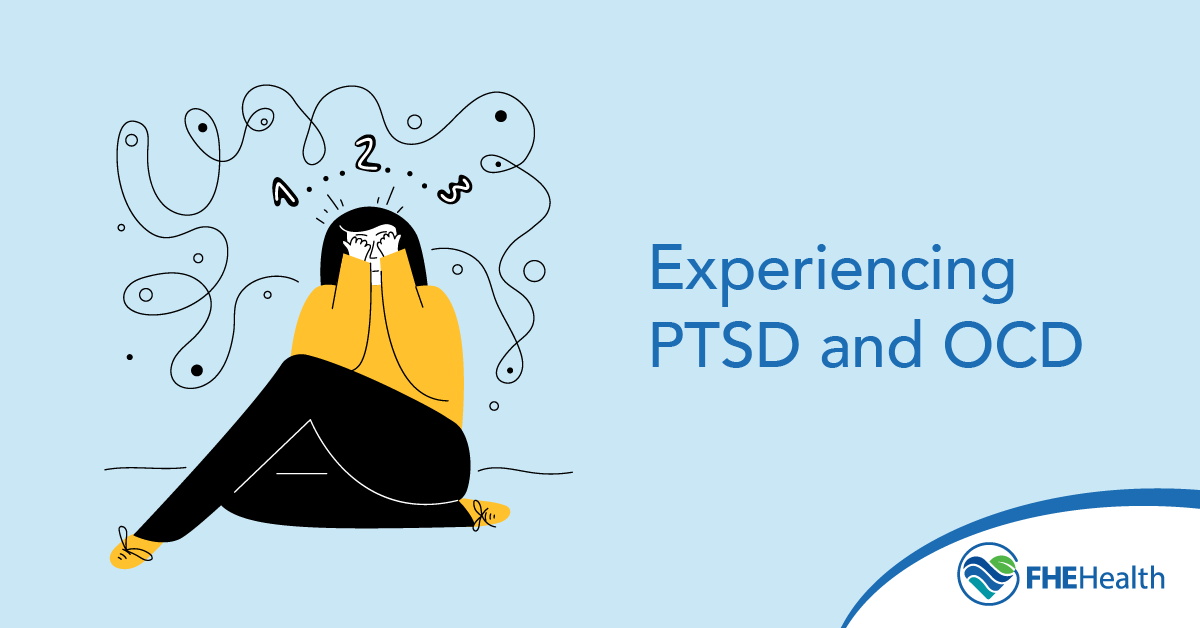
Post-traumatic stress disorder (PTSD) and obsessive-compulsive disorder (OCD) are complex mental health conditions that affect many people. Interestingly, PTSD and OCD often co-occur. Someone who survives a traumatic experience may develop post-traumatic OCD as well as PTSD.
This article discusses the link between OCD and trauma, how the symptoms of PTSD and OCD often overlap and the challenges of treating someone with both conditions.
Overview of PTSD and OCD as Separate Conditions
An estimated 6% of people in the United States will have PTSD at some point in their lives, with women more likely to develop it than men. Veterans, especially those who’ve been deployed in a combat zone, are more likely to develop PTSD than civilians.
People living with PTSD may have nightmares or flashbacks related to their trauma. They might be irritable and easily startled or choose to isolate themselves due to the anxiety and guilt surrounding their trauma. These behaviors can lead to sleep issues, difficulty with interpersonal relationships and physical symptoms like headaches or digestive problems.
OCD is another serious mental health condition that affects an estimated 1% to 3% of the population worldwide. This condition is characterized by intrusive thoughts or obsessions. A person with OCD may engage in repetitive actions or obsess over details to the point that it interferes with their ability to lead a normal life.
OCD isn’t simply a high attention to detail or desire for cleanliness. People with OCD experience extreme distress if they can’t satisfy their impulses or follow their usual rituals. OCD often exists alongside other mental health challenges, making it more difficult to treat.
How Symptoms Can Overlap and Interact
When someone has experienced trauma and is already exhibiting PTSD-like behaviors like hyperarousal or a desire to avoid certain situations, they might begin to exhibit trauma-related OCD symptoms.
For example, they might engage in compulsive behaviors in an attempt to manage distressing thoughts related to the trauma. The relief these behaviors provide is only temporary, however, and if the person is engaging in avoidant behaviors, they might find themselves in a spiral of isolation, guilt and repetitive rituals.
The Link Between Trauma and Compulsive Behaviors
When a person goes through a traumatic experience, their brain tries to process it. In some cases, the trauma is so severe that it’s impossible to process it simply by thinking about it. Some people with PTSD obsess about the traumatic event itself, while others attempt to cope by focusing on other things in a way that can lead to obsessive thoughts or compulsive rituals.
For example, if someone fears for their physical safety, they might decide to take steps to secure their home. Checking that doors are locked before going to bed is a rational action. Re-checking repeatedly, to the point that it becomes a compulsion, is an obsessive behavior that stems from a need to control the environment.
Not all obsessive behaviors stem from OCD; they may relate to anxiety or PTSD. However, a pattern of intrusive thoughts and compulsive behavior in someone with a history of trauma could be a sign of post-traumatic OCD.
Challenges in Diagnosis and Treatment
Diagnosing post-traumatic OCD can be difficult because the symptoms overlap with typical PTSD and generalized anxiety disorder (GAD). If the individual doesn’t disclose that they’ve been through a traumatic event, a post-traumatic OCD diagnosis could be overlooked.
Integrated Therapy Approaches for Co-Occurring PTSD and OCD
It’s possible to treat PTSD and OCD, and one of the most effective treatment options is cognitive behavioral therapy. This form of talk therapy helps a person identify and change dysfunctional thoughts and behaviors. During CBT, a person learns to replace negative thoughts with new, healthier beliefs. They also learn coping strategies they can use in triggering environments.
CBT is often combined with exposure and response prevention (ERP) therapy, during which the individual is exposed to their intrusive thoughts and guided to stop the compulsive behavior that typically follows. Over time, this can help a person living with OCD reduce their anxiety when they’re unable to act on intrusive thoughts.
Another therapy that’s seeing increasing use is eye movement desensitization and reprocessing (EMDR) treatment. This therapy uses bilateral stimulation, such as sounds through headphones or repetitive eye movements, to change how the brain processes traumatic events and make the emotional response to those events less powerful.
Medication can be used to alleviate some of the symptoms of OCD in the short term. However, it’s typically used alongside therapy to provide a longer-lasting solution.
Living With and Managing Both Conditions
PTSD and OCD can have a huge impact on a person’s life, making it hard for them to work, socialize and maintain relationships with friends and family members. With a good support network and healthy coping mechanisms, it’s possible to manage both OCD and PTSD. Avoiding drugs and alcohol can also help, as these substances can impair your ability to process emotions in a healthy way.
The recovery journey can be long. Even years after a traumatic event, a person might discover new triggers or experience a fluctuating ability to cope with challenging situations. This is normal, and communicating with loved ones while working with a therapist can ease the journey to recovery.
At FHE Health, we provide support for people living with PTSD and OCD as well as anxiety, depression and other mental health disorders. We also work with people struggling with substance abuse.
To learn more about the support we offer, verify your insurance or book an appointment with the admissions team, contact FHE Health today.






